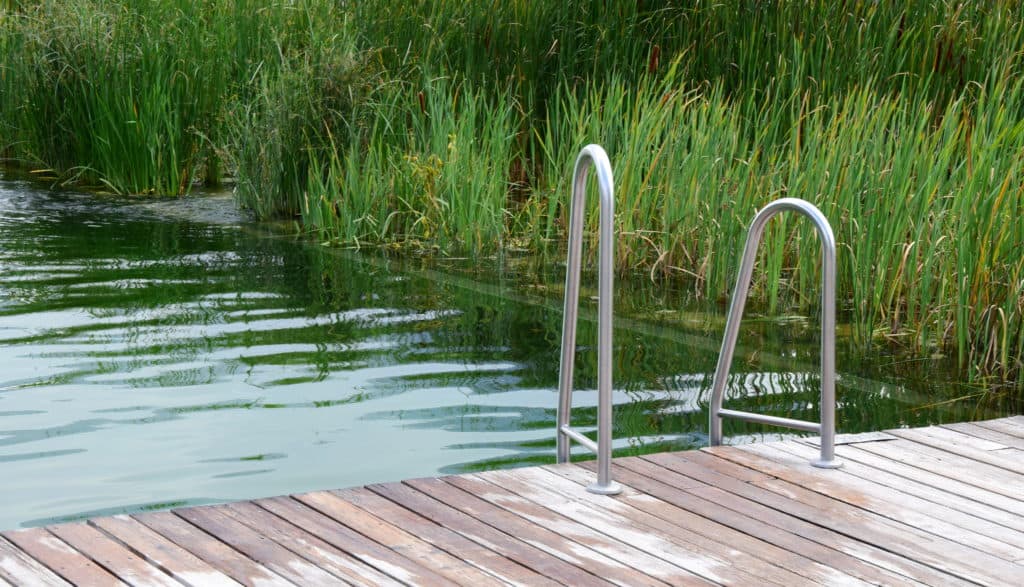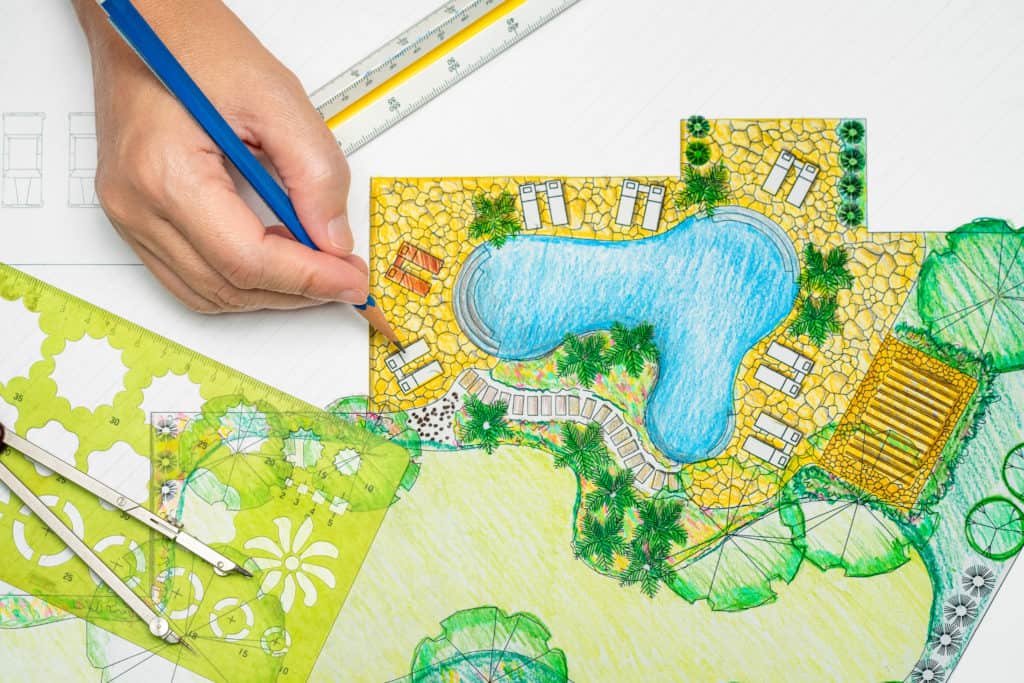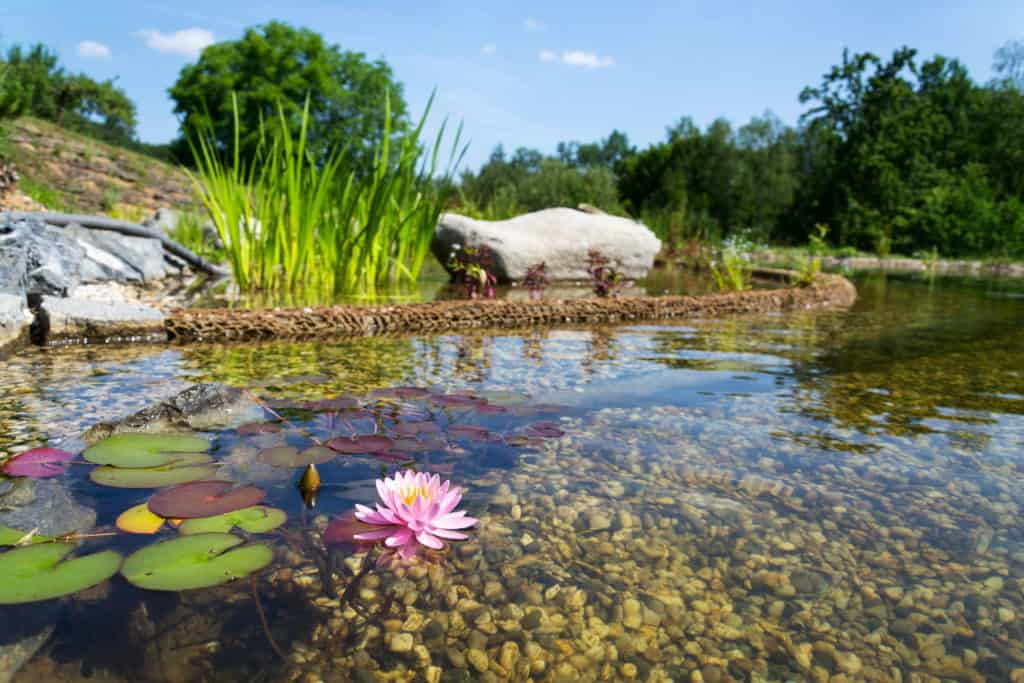
With a swimming pond, you can bring a piece of quarry pond home. The swimming pond is not a swimming pool because it blends harmoniously with nature and has different water zones, just like a garden pond. The swimming pond combines a garden pond and a swimming pool. You equip the swimming pond with plants, even if you use them more sparingly than in a garden pond, which is unsuitable for swimming. The swimming pond uses fewer chemicals than a swimming pool. Learn in this article what you should consider when planning, building, and cleaning the swimming pond.
What you Should Know About a Swimming Pond
The swimming pond is a mixture of a swimming pool and a biotope. As a biotope, it is a natural design element in your garden. The water does not need to be cleaned chemically. As a biotope, the pond is characterized by biological self-cleaning. You have less work with cleaning than with a swimming pool. However, the water does not remain completely clear. Therefore, you should not do without technology such as a pump and filter.
A swimming pool offers more space for swimming than a swimming pond, but it does not come without a chemical mace to keep the water clean. You can only prevent algae and bacteria from settling in a swimming pool using the appropriate maintenance products. It would be best if you also cleaned the pool regularly to keep its beautiful light blue color.
A swimming pond combines the advantages of a garden pond and a swimming pool. It provides a new kind of habitat for plants, animals, and people, and you can enjoy nature and have fun in the water. Since the swimming pond is also a biotope, animals like frogs and newts can settle by themselves. You can use fish, but you should use them somewhat sparingly. Fish are not a must.
The water in a swimming pond is much more skin-friendly than in a swimming pool because it does not contain chlorine. Almost without help, the water cleans itself. Since the swimming pond does not use chemicals and requires less maintenance, the annual costs are lower than a swimming pool.
How to Plan Your Swimming Pond
Just like any other garden pond, a swimming pond requires good planning so that you can enjoy it later. You should take a sheet of paper and sketch out your pond to scale if possible. In your sketch, you should also draw the depths of the individual zones.

At its deepest point, the swimming pond should be about 6.5 feet (two meters) deep. This will provide a high volume of water. The effort for pond maintenance is lower because the pond can regulate itself better with a high water volume and at the appropriate depth. Algae formation is also lower when the pond can regulate itself. In winter, the pond will not freeze to the bottom with a greater depth. The water values remain more stable with a greater depth. In the summer, the water stays cooler, even in the deeper layers. A deeper pond can bind oxygen better. This benefits the pond inhabitants and the water level.
A large pond requires more effort to build, as more excavation is needed. Basic cleaning after winter is also a bit more involved.
When planning your swimming pond, it also depends on the correct location. Only if you have a lot of space on your property, a swimming pond makes sense. Furthermore, you should pay attention to a suitable place with
- sunlight
- distance from the edge of the neighboring property
- wind direction
The location should be as protected from the wind as possible. Sun is lovely when you are in the pond, but intense sunlight heats the pond quickly. Evaporation is also high on hot summer days. A semi-shaded location is well suited. Many native plants are also suitable for partial shade.
The Construction of the Swimming Pond
You should divide your swimming pond into a swimming zone and a regeneration zone. You can swim your lanes in the swimming zone, but space is much smaller than in a swimming pool. In this zone, you can also splash and relax. Swimming fun is the main focus in this zone. Therefore, the swimming zone should be appropriately deep.
The regeneration zone is also called the treatment or shallow water zone. It should make up about 30 to 70 percent of the total pond area. This zone ensures the biological balance in your pond and reduces the amount of maintenance required. How large you choose this zone also depends on the intensity of use, the water’s nutrient content, and the amount of sunlight. Purification of the water is achieved by marsh and aquatic plants. The plants enrich the water with oxygen and reduce the nutrient content. This minimizes the formation of algae.

Together with the microorganisms in your pond, the aquatic plants reduce germs and pollutants in the water. The clarified water returns to the swimming zone. Much of the cleaning is done by nature in a swimming pond. The swimming pond represents a circulation system.
What You Should Consider in Terms of Technology
A swimming pond cannot do entirely without technology, even though the plants make an essential contribution to a biological balance and clean water. A technical filter system should support the biological filter system. This is especially important if you use your swimming pond intensively. The filter system decimates germs and absorbs nutrients. In this way, you counteract the growth of algae. You also prevent various substances in the water from being converted into toxins with the filter system.
A surface skimmer sucks organic material from the water surface. Leaves that have fallen into the water, plant parts, and other things that do not belong in the water are removed with the surface skimmer. The surface skimmer prevents this material from sinking. In this way, fewer nutrients are formed. The formation of algae is counteracted. A pump pumps the water through a shaft into the shallow water area. The water passes through fine mechanical filtration. In the regeneration zone, you should use gravel. Through the gravel in the regeneration zone, the water gets back to the swimming zone.
You can also use other technology for the swimming pond. Which technology you integrate into your swimming pond depends on your pond, on the size, and the plants in it.
The Natural Cleaning of the Swimming Pond
A key advantage in a swimming pond over a swimming pool is the absence of chlorine and other chemical substances. Such substances make the water clean, but it is not natural. Biological purification in a swimming pond provides pure and natural water. To achieve biological purification through a natural filtration system, you should consider five points:
- Shore Substrate
In the shallow water zone, the bank substrate should form a base with a thickness of 12 to 28 inches (30 to 70 centimeters). This substrate removes nutrients from the water as beneficial bacteria colonize it. - Reposition Plants in the Shallow Water Zone
As reposition plants, you should choose native plants. They are hardy and cope well with cold temperatures. They are hardy. When selecting plants, you should make sure that these plants produce as much oxygen as possible. You will get different plants that have species-specific effects on water quality. It would be best if you matched the plants to each other. Furthermore, it would help if you also matched the plants to the number of expected bathers and the nature of the water being fed. - Circulation of the Water
Another aspect is the circulation of the water. Here you can not completely do without the technology. You can also design a swimming pond with a stream that you create with natural stones. A pump system can make the water flow through the stream. The water is well enriched with oxygen, and this has a positive effect on the water level. - Planktonic filtration
Planktonic filter feeders are microorganisms. In a well-designed swimming pond, such microorganisms find good living conditions. These tiny organisms contribute significantly to keeping the water clean. The formation of algae is thus avoided. - Animals in the Swimming Pond
Valuable animals in the swimming pond also play an essential role in water quality. Water snails are helpful because they eat algae from the surfaces of foil and stones. If you have many plants in the shallow water zone and on the shore, dragonflies can also settle. The dragonfly larvae counteract the emergence of mosquitoes. Mussels and crayfish remove organic material from the bottom.
Despite this natural cleaning of the water, you cannot completely do without technology in your swimming pond.
Conclusion
A swimming pond combines the advantages of a garden pond and a swimming pool. To swim comfortably, you should pay attention to the correct size. A large pond can better support itself. At its deepest point, the swimming pond should be about 6.5 feet (two meters) deep. You should divide the swimming pond into a swimming zone and a regeneration zone. A swimming pond does not need any chemicals because it cleans itself for the most part. You can not completely do without technology. You should use a filter to counteract the formation of algae and toxins.